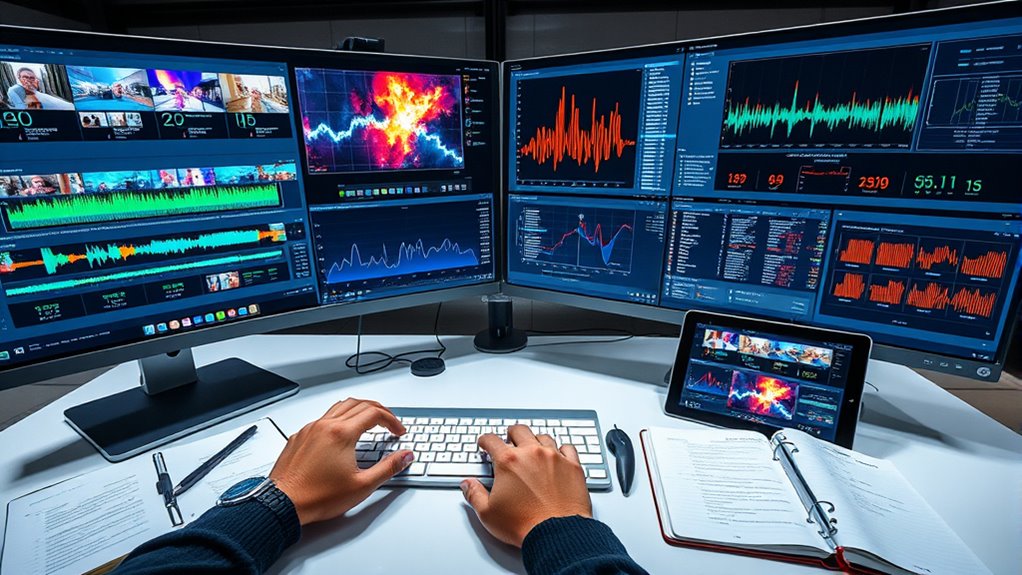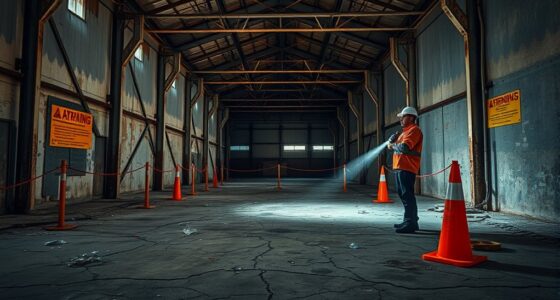To perform our video analysis workflow, you start by segmenting footage into key parts based on scene changes or content, which helps focus on relevant areas. You then guarantee high-resolution footage for better accuracy during segmentation and motion tracking. After that, you export these segments to tracking software, adjusting parameters for ideal results. Regular validation and automation improve efficiency and reliability, so if you keep exploring, you’ll discover how each step enhances overall analysis quality.
Key Takeaways
- Begin with precise video segmentation to isolate relevant scenes and reduce processing load.
- Utilize high-resolution footage to improve segmentation accuracy and motion tracking detail.
- Export segmented segments to specialized software, ensuring data compatibility and quality retention.
- Apply automated tools for motion tracking, followed by validation to correct errors and refine results.
- Maintain detailed records of parameters and adjustments to ensure workflow consistency and reproducibility.

Analyzing video footage efficiently starts with a clear workflow that streamlines each step of the process. The foundation of this workflow is effective video segmentation, which involves breaking down the footage into manageable segments based on content, motion, or scene changes. By performing precise video segmentation early on, you can focus your attention on relevant portions, reducing processing time and increasing accuracy. Once you’ve segmented the video, you can prioritize specific sections for detailed analysis, ensuring that you’re not wasting resources on irrelevant data. Incorporating accurate segmentation also helps in setting up subsequent steps, like motion tracking, by defining the areas of interest from the outset. Additionally, understanding the importance of projector resolution can significantly enhance the quality of your video analysis, especially when working with high-definition footage.
Effective video segmentation early streamlines analysis, saving time and boosting accuracy by focusing on relevant footage.
Motion tracking is a core component of the workflow that follows. After segmenting the video, you identify objects or features you want to analyze over time. Using motion tracking algorithms, you can follow these objects frame by frame, capturing movement patterns, trajectories, and interactions. This step is vital for applications like security surveillance, sports analytics, or film editing, where understanding motion dynamics is essential. To optimize motion tracking, you should calibrate your software with the specific characteristics of your footage, such as resolution, lighting conditions, and object speed. Proper calibration minimizes errors and guarantees consistent tracking accuracy throughout the analysis.
A key aspect of an effective workflow is maintaining a smooth progression between video segmentation and motion tracking. Once you’ve segmented the video, you export the relevant segments into your motion tracking software. This process involves ensuring that data formats are compatible and that the segments retain their original quality. As you continue, you can refine the tracking by adjusting parameters, such as tracking points or algorithms, to improve precision. Throughout this process, keeping detailed records of your settings and adjustments helps in troubleshooting and reproducing results later.
Automation plays a significant role in streamlining your analysis workflow. Many modern tools offer automated segmentation and motion tracking features that save time and reduce manual effort. However, always review automated outputs to catch any errors or misalignments. Regularly updating your workflow with the latest software improvements ensures you benefit from enhanced algorithms, better accuracy, and faster processing speeds. Incorporating validation checkpoints at key stages — like post-segmentation and post-tracking — guarantees your analysis remains reliable and consistent.
Frequently Asked Questions
What Software Tools Are Essential for Video Analysis?
You need software tools like Adobe Premiere Pro or DaVinci Resolve for effective video analysis. These tools let you perform motion detection to identify movement patterns, and color grading to analyze visual details and enhance footage clarity. They also offer features like frame-by-frame review and metadata extraction, helping you interpret data accurately. With these tools, you streamline your analysis process, making it easier to uncover insights and improve your video projects efficiently.
How Long Does a Typical Video Analysis Take?
A typical video analysis takes anywhere from a few hours to several days, depending on the video’s length and complexity. You’ll spend time on video annotation, carefully labeling key elements, and applying motion tracking to follow movement accurately. The more detailed your analysis, the longer it takes. So, plan accordingly, and remember that precision in video annotation and motion tracking guarantees better insights and results.
Can the Workflow Be Customized for Different Industries?
Yes, you can customize the workflow for different industries by incorporating industry-specific adaptations and tailored analysis protocols. This flexibility allows you to focus on relevant metrics and specific challenges unique to your sector. By adjusting these protocols, you guarantee more accurate insights and better decision-making, regardless of your industry. Customization helps you optimize the process, making your video analysis more effective and aligned with your organization’s goals.
What Are Common Challenges Faced During Video Analysis?
Think of video analysis as steering through a maze; you’ll often encounter dead ends like poor video quality or inconsistent footage. You might struggle with unclear visuals, making it hard to spot details. Additionally, analyst training plays a vital role—without proper skills, even high-quality videos can be misinterpreted. These challenges slow down your workflow and compromise accuracy, but with the right tools and training, you can turn obstacles into opportunities for sharper insights.
How Do We Ensure Data Privacy During the Process?
You guarantee data privacy by implementing robust data encryption, both during storage and transmission, to protect sensitive information. Additionally, you set strict access controls, allowing only authorized personnel to view or modify the data. Regular audits and monitoring further help you detect any unauthorized access or breaches, maintaining confidentiality throughout the video analysis process. This proactive approach keeps your data secure and compliant with privacy standards.
Conclusion
Think of your video analysis workflow as a well-oiled machine, each step turning smoothly into the next. When you stay organized and follow your process, insights flow effortlessly like a river carving its path. With focus and precision, you’ll uncover valuable details that otherwise might stay hidden. Keep refining your steps, and your analysis will become a powerful current, guiding you toward clearer understanding and smarter decisions every time.









